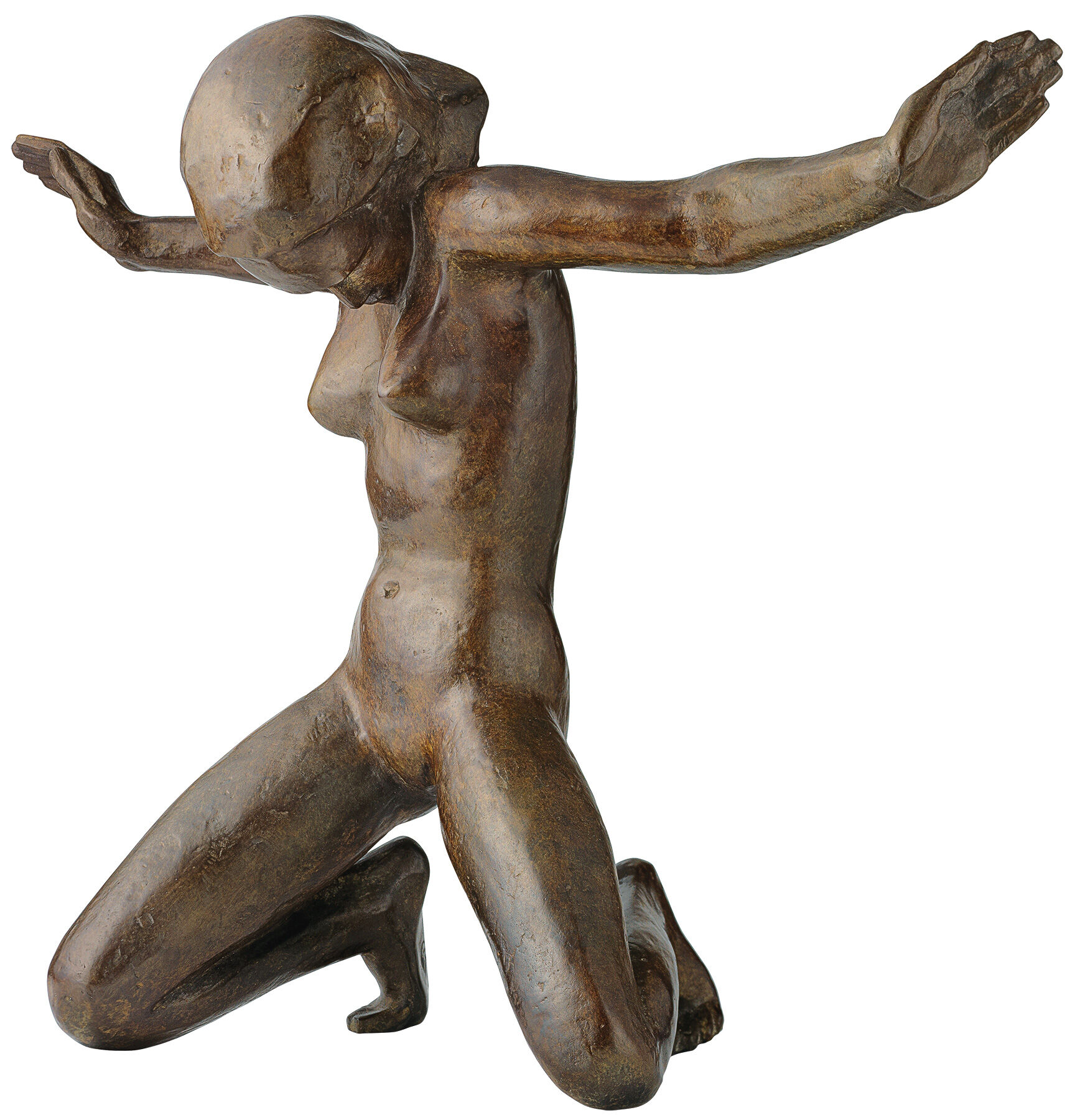Sculpture "Grief" (1921), bronze
Sculpture "Grief" (1921), bronze
Quick info
ars mundi Exclusive Edition | limited, 199 copies | numbered | signature | foundry hallmark | bronze | patinated | size 38 x 52.5 x 23 cm (h/w/d) | weight approx. 11 kg
Video
Detailed description
Sculpture "Grief" (1921), bronze
In 1912, Georg Kolbe caused a sensation in Berlin with his "Dancer" - his most famous work to date. The theme of dance and the expressive, even ecstatic movement pervades his sculptural work well into the 1920s, as it does in his Kneeling Woman, created in 1921.
In the decade between these two works, Kolbe had received the title of professor (1918) and - together with Ernst Barlach and Wilhelm Lehmbruck - was admitted to the Prussian Academy of Arts (1919). In the 1920s, he was undisputedly considered to be one of the most influential sculptural artists in Germany. As a result, he came to the attention of major art collectors all over the world. One copy later found its way into the legendary Nelson Rockefeller art collection - the model for our exclusive edition.
Original: Rockefeller Collection/The Museum of Modern Art (MoMA).
Sculpture in fine bronze, patinated. Hand-cast using the Lost-Wax-Process. Directly cast from the original. Limited edition of 199 copies, individually numbered and signed and bearing the foundry hallmark. Size 38 x 52.5 x 23 cm (h/w/d). Weight approx. 11 kg. ars mundi Exclusive Edition.
Customer reviews

About Georg Kolbe
1877-1947
It was only during a stay in Rome from 1898 to 1901 that Georg Kolbe began to engage with sculpture. The artist, who was born in Waldheim, Germany, in 1877, had travelled to Rome as an already trained painter and graphic artist who had studied in Dresden, Munich and Paris in the previous seven years and already had some initial successes. As with many artists of his generation, Rodin's work in Paris had made a deep impression on him, and since the sculptor Louis Tuallion offered and provided him with technical support during his first attempts in Rome, he quickly found his way into sculptural work. It was not until 1904, in Berlin, that he decided to concentrate entirely on the art of sculpture. Kolbe quickly gained recognition: he became a member of the Berlin Secession and Paul Cassirer, the city's most important art dealer, soon represented him.
With his "Dancer" (1910) he finally had his breakthrough. He joined the ranks of the most important German sculptors of his time. The "Dancer" is still one of his most famous works today and is said to have become an idol with its "modern" hairstyle and its self-forgetful posture reminiscent of the highly topical expressive dance of the time, to which the art-interested youth made a veritable pilgrimage.
The nude figure continued to be at the centre of his work, often linked with the motif of dance until the 1920s. Kolbe's works after World War I bear witness to his involvement with Expressionism, later turning towards the classical monumental. When Kolbe died in 1947, he left behind a body of work that can be found in renowned collections all over the world.
An alloy of copper with other metals (especially with tin) used since ancient times.
When casting bronze, the artist usually applies the lost-wax technique which is dating back more than 5000 years. It's the best, but also the most complex method of producing sculptures.
First, the artist forms a model of his sculpture. It is embedded in a liquid silicone rubber mass. Once the material has solidified, the model is cut out. The liquid wax is poured into the negative mould. After cooling down, the wax cast is removed from the mould, provided with sprues and dipped into ceramic mass. The ceramic mass is hardened in a kiln, whereby the wax flows out (lost mould).
Now we finally have the negative form, into which the 1400° C hot molten bronze is poured. After the bronze had cooled down, the ceramic shell is broken off and the sculpture is revealed.
Now the sprues are removed, the surfaces are polished, patinated and numbered by the artist himself or, to his specifications, by a specialist. Thus, each casting becomes an original work.
For lower-quality bronze castings, the sand casting method is often used which, however, does not achieve the results of a more complex lost-wax technique in terms of surface characteristics and quality.
Graphic or sculpture edition that was initiated by ars mundi and is available only at ars mundi or at distribution partners licensed by ars mundi.
Term for an art object (sculpture, installation), which is produced in multiple copies in a limited and numbered edition according to the artist‘s will.
Artist's multiples have been called the most accessible and affordable art on the market.
A plastic work of sculptural art made of wood, stone, ivory, bronze or other metals.
While sculptures from wood, ivory or stone are made directly from the block of material, in bronze casting a working model is prepared at first. Usually, it is made of clay or other easily mouldable materials.
The prime time of sculpture after the Greek and Roman antiquity was the Renaissance. Impressionism gave a new impulse to the sculptural arts. Contemporary artists such as Jorg Immendorf, Andora, and Markus Lupertz also enriched sculptures with outstanding works.






